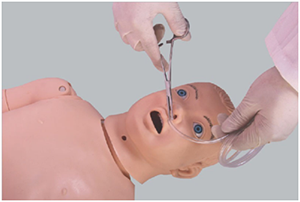26-11-2024
ADA MED SUPPLY LIMITED
In the field of pediatric nursing, the pediatric nasogastric tube model as an important teaching and practice tool has been widely welcomed and preferred. This is mainly due to the multiple advantages of the model, which make it a useful aid in pediatric nursing education and clinical practice.
First of all, it can highly simulate the physiological structure and nasal feeding process of real children. The model is usually designed for realistic appearance and internal structure, and can accurately reflect the anatomical characteristics of the nasal cavity, esophagus, and stomach in children. This highly simulated design allows the nursing staff to be closer to the real operating environment during the practice process, so as to better understand and master the nasal feeding skills.

Secondly, the model has a variety of functions and can meet the needs of different levels of nursing training. For example, the model can simulate various situations during nasal feeding in children, including normal nasal feeding, difficulty in inserting gastric tubes, gastric reflux, etc. These simulated situations can help nurses familiarize themselves with the nasal feeding process and improve their ability to cope with various emergencies. At the same time, the model can also be used to practice operations such as measuring, inserting and fixing nasogastric tubes, so that caregivers can become more proficient in these basic skills.
In addition, it has the advantages of simple operation and easy maintenance. Models are often designed with clear labeling and instructions so that caregivers can quickly understand and use them. At the same time, the material and construction of the model also make it easy to clean and maintain, thus extending the service life and reducing maintenance costs.
In pediatric nursing practice, the application of pediatric nasal feeding tube model has also achieved remarkable results. Through the practice of the model, the nursing staff can be more confident in the real operation of pediatric nasal feeding, reducing the occurrence of operational errors and complications. At the same time, the use of the model also improves the team cooperation and emergency handling ability of nurses, and provides a strong guarantee for the safety and rehabilitation of children.
In summary, the pediatric nasal feeding tube model has become an important tool in pediatric nursing education and clinical practice due to its advantages of high simulation, diverse functions, simple operation and easy maintenance. This is also the main reason for pediatric nursing preference for pediatric nasogastric tube model.